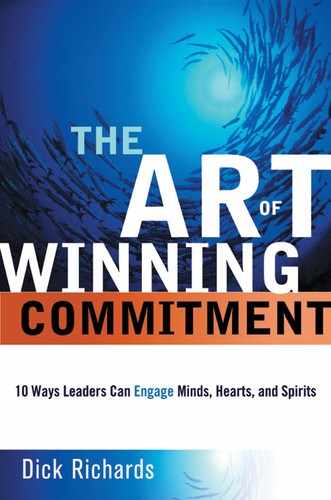![]()
PART3
WINNING SPIRITUAL
COMMITMENT
THE NEXT THREE CHAPTERS DESCRIBE THE COMPETENCIES FOR winning spiritual commitment: rendering significance, enacting beliefs, and centering. The character of the effort needed to win spiritual commitment is different from that of winning either intellectual or emotional commitment. Winning intellectual commitment and winning emotional commitment can each be described as processes with preconditions and outcomes. Insight and vision are preconditions for telling a compelling story, which in turn produces the opportunity to mobilize people and win intellectual commitment. Self-awareness and creative use of self are preconditions for emotional engagement, which in turn provides the opportunity to foster hope and win emotional commitment. Winning spiritual commitment, however, is less of a linear affair. It requires a leader to create a kind of energy field, an atmosphere, which suffuses all of her attempts to win intellectual and emotional commitment. In order to win spiritual commitment, a leader’s insight, vision, story, and attempts to mobilize must be suffused with spirit. Spirit must also permeate his self-awareness, emotional engagement, and efforts to foster hope. This is shown in Figure Part 3-1.
Figure Part 3-1. Winning spiritual commitment requires that a leader create an atmosphere that circumscribes all of his attempts to win intellectual and emotional commitment.
Leaders who win spiritual commitment do not impose their efforts to do so upon their efforts to win intellectual and emotional commitment; rather, spirit is the ground on which those latter efforts rest. Winning spiritual commitment in an organization is not a matter of “bringing spirit into the workplace” or “implementing spirit.” Spirit is already and inevitably on the premises. The CEO of a training and development company, a respected leader, was speaking to a Native American healer about his attempts to bring spirit to his company and to other organizations. This puzzled the Native American healer, who thought it preposterous to think that spirit was not present. “It may be suffering,” said the healer, “but it is always present.” A leader’s role is not bringing spirit, but releasing and or healing it, and then offering it direction.
Spiritually committed people are “on a mission” that involves a long-term commitment to transform a community, which may be as large as human society itself or as small as a nuclear family.

